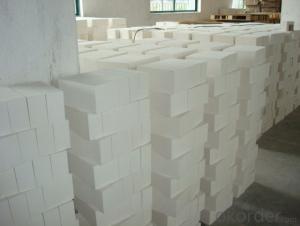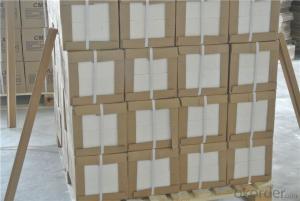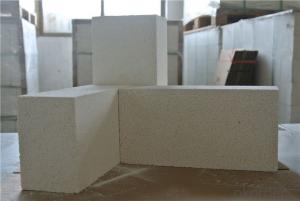Fire Light Mullite Insulation Brick Product
- Loading Port:
- Shanghai
- Payment Terms:
- TT OR LC
- Min Order Qty:
- 1 m.t.
- Supply Capability:
- 10000 m.t./month
OKorder Service Pledge
OKorder Financial Service
You Might Also Like
Thermal Insulation Fire Clay Brick
Refractory brick is a refractory material used in lining furnaces, kilns, fireboxes, and fireplaces.
We provide high quality Refractory Fire Bricks that are used on wide range in the various industries like Cement, Glass and Steel. Refractory Fire Bricks are provided as per the quantity and specifications required by the customers. We provide an extensive range of Refractory Fire Bricks at reasonable prices that depend upon the quantity ordered.
Application
Insulating Fire Brick are used for the lining of converter, alternating current arc furnace, direct Current arc furnace and the ladle slag line, etc.
Company Advantage
(1)Long Insulating Fire Brick manufacture history: 25 years manufacturer
(2)Advanced equipment and good service
(3)Diversification of production standards: ISO ANSI FEPA JIS ASTM
(4)Flexible payment: T/T L/C D/P D/A
(5)Professional marketing team and after-sale service
Insulating Fire Brick main feature:
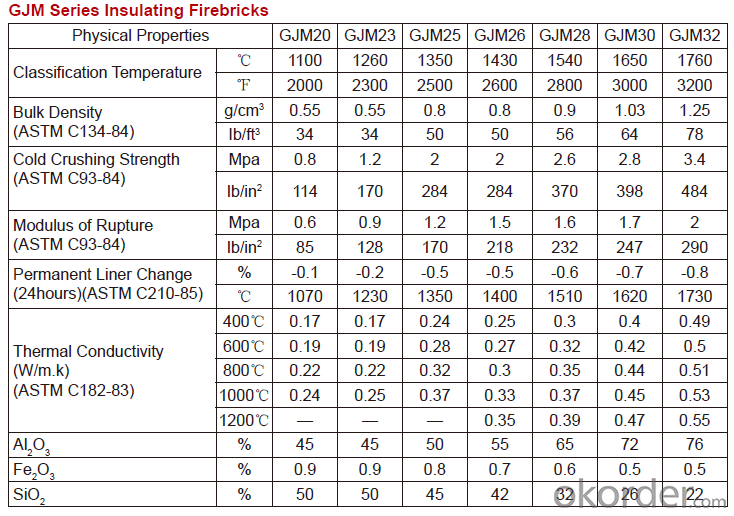
Equipment
1 unit of Ceramic Abrasive (SG Abrasive) pilot production line
2 units of Compact grain Abrasive pilot production lines
1 unit of high-end coated abrasives (abrasive cloth) production line
3 large flexible crushing and sieving lines for grit production lines
6 units of 5000KVA-10000KVA dumping type electric arc furnaces for Brown Fused Alumina fusion
FAQs
Q1 What’s the transport method?
A1 FCL delivery goods with wooden pallet or wooden case by sea; If LCL delivery, must with wooden case; Sometimes need open top, flat rack or bulk cargo.
Q2 What’s the required payment term?
A2 Generally 30% TT as the prepayment, 70% TT before delivery. If need, 100% Irrevocable Letter of Credit or negotiation.
Q3 Which country are our products exported to?
A3 Apart from entire Chinese market, the US, Russia, Japan, Korea, Australia and some Southeast Asian Nations.
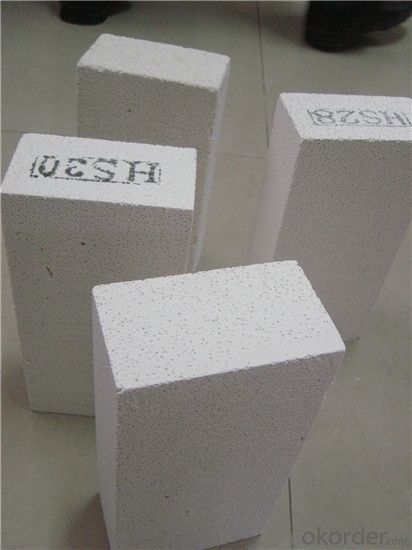

- Q:What is the typical open porosity of an insulating fire brick?
- The open porosity of insulating fire bricks can vary depending on the specific type and manufacturer. On average, these bricks have an open porosity ranging from 45% to 70%, meaning that around 45% to 70% of their volume consists of interconnected voids or pores. This characteristic is crucial for their thermal insulation properties. The brick's insulating capabilities improve with higher open porosity since the voids serve as barriers to heat transfer. However, insulating fire bricks with lower open porosity tend to be denser and more durable, although their thermal insulation properties may be reduced.
- Q:Can insulating fire bricks be used in boilers for steam generation?
- Yes, insulating fire bricks can be used in boilers for steam generation. Insulating fire bricks are made from lightweight materials that have high insulating properties, such as ceramic fibers or expanded clay. These bricks are designed to have low thermal conductivity, which means they are excellent at preventing heat transfer. In boilers, the insulation is crucial to reduce heat loss and improve energy efficiency. Insulating fire bricks can be used to line the walls, roof, and floor of the boiler combustion chamber. By providing a highly insulating barrier, they help to retain heat within the combustion chamber, allowing for more efficient steam generation. Furthermore, insulating fire bricks can withstand high temperatures, making them suitable for use in boilers where steam generation involves elevated temperatures. They are also resistant to thermal shock, which is important in boilers where temperature fluctuations can occur. Overall, insulating fire bricks are a valuable choice for boiler applications as they provide excellent insulation, withstand high temperatures, and contribute to improved energy efficiency in steam generation.
- Q:How do insulating fire bricks compare to other types of refractory materials?
- IFBs, or insulating fire bricks, are refractory materials specially designed for their high insulating properties. They have several advantages when compared to standard fire bricks or castable refractories. First and foremost, IFBs have lower thermal conductivity than other refractory materials. This means they are more effective at preventing heat loss and providing insulation for high-temperature applications. Their low thermal conductivity allows them to retain heat within furnaces or kilns, resulting in reduced energy consumption and improved efficiency. Additionally, IFBs are lightweight, making them easier to handle, transport, and install. Their lightweight nature also reduces the overall weight of the refractory lining, which can be advantageous in certain situations. Another benefit of IFBs is their ability to withstand rapid temperature changes. They exhibit good thermal shock resistance, meaning they can endure sudden temperature fluctuations without cracking or spalling. This property is particularly valuable in applications with frequent heating and cooling cycles. Furthermore, IFBs possess a high level of chemical resistance. They can withstand corrosive environments and chemical attacks, making them suitable for various applications involving acids, alkalis, and other aggressive substances. However, IFBs do have limitations. Their lower density compared to standard fire bricks means they are less durable and have lower mechanical strength. Therefore, they might not be suitable for applications that require high load-bearing capacity or are prone to heavy abrasion. To summarize, IFBs offer excellent thermal insulation, lightweight properties, good thermal shock resistance, and high chemical resistance. Nonetheless, their lower density and reduced mechanical strength may restrict their usage in certain scenarios. It is crucial to carefully consider the specific requirements of the application before selecting IFBs or alternative refractory materials.
- Q:Are insulating fire bricks resistant to acids?
- Yes, insulating fire bricks are generally resistant to acids. They are made from materials that can withstand high temperatures and are chemically stable, making them suitable for applications where acid resistance is required.
- Q:Is it possible to repair damaged insulating fire bricks?
- Yes, it is possible to repair damaged insulating fire bricks. The extent and type of damage will determine the repair method required. For minor cracks or chips, a suitable refractory mortar can be used to fill in the gaps and restore the brick's integrity. This mortar is designed to withstand high temperatures and provide a strong bond. If a larger section of the brick is damaged or missing, it may be necessary to replace the entire brick. In this case, the damaged brick can be carefully removed and a new one can be installed using the appropriate refractory mortar. It is important to note that the repaired or replaced brick should match the original specifications and quality to ensure proper insulation and structural integrity. It is recommended to consult with a professional or follow the manufacturer's guidelines for the specific repair process.
- Q:Can insulating fire bricks be used in the construction of smelter crucibles?
- Yes, insulating fire bricks can be used in the construction of smelter crucibles. These bricks are designed to withstand high temperatures and provide excellent insulation, making them suitable for use in smelting applications. They help to retain heat and minimize heat loss, ensuring efficient and effective smelting processes.
- Q:Can insulating fire bricks be used in smelting furnaces?
- Yes, insulating fire bricks can be used in smelting furnaces. Insulating fire bricks are specifically designed to withstand high temperatures and provide excellent thermal insulation. They help in reducing heat loss and improving energy efficiency in the smelting process.
- Q:Can insulating fire bricks be used as a lining for kiln cars?
- Yes, insulating fire bricks can be used as a lining for kiln cars. These bricks are designed to withstand high temperatures and have excellent insulating properties, making them ideal for use in kilns where heat retention is required. Additionally, their lightweight nature makes them suitable for use on kiln cars, which need to be moved frequently.
- Q:Are insulating fire bricks resistant to mold or mildew?
- No, insulating fire bricks are not resistant to mold or mildew. These types of bricks are specifically designed to withstand high temperatures and provide excellent insulation, but they do not possess any inherent resistance to mold or mildew growth. Mold and mildew can still develop on the surface of insulating fire bricks if they are exposed to moisture or damp conditions. To prevent mold or mildew growth, it is important to ensure that the bricks are kept dry and well-ventilated. Regular cleaning and maintenance can also help in preventing the growth of mold or mildew on the surface of insulating fire bricks.
- Q:Can insulating fire bricks be used in brick ovens?
- Yes, insulating fire bricks can be used in brick ovens. Insulating fire bricks are designed to withstand high temperatures and provide excellent heat insulation, making them ideal for use in brick ovens. These bricks are made from lightweight refractory materials, which help to reduce heat loss and improve the overall energy efficiency of the oven. Additionally, insulating fire bricks are resistant to thermal shock, meaning they can withstand rapid changes in temperature without cracking or breaking. This makes them a reliable and durable choice for brick oven construction.
1. Manufacturer Overview |
|
|---|---|
| Location | |
| Year Established | |
| Annual Output Value | |
| Main Markets | |
| Company Certifications | |
2. Manufacturer Certificates |
|
|---|---|
| a) Certification Name | |
| Range | |
| Reference | |
| Validity Period | |
3. Manufacturer Capability |
|
|---|---|
| a)Trade Capacity | |
| Nearest Port | |
| Export Percentage | |
| No.of Employees in Trade Department | |
| Language Spoken: | |
| b)Factory Information | |
| Factory Size: | |
| No. of Production Lines | |
| Contract Manufacturing | |
| Product Price Range | |
Send your message to us
Fire Light Mullite Insulation Brick Product
- Loading Port:
- Shanghai
- Payment Terms:
- TT OR LC
- Min Order Qty:
- 1 m.t.
- Supply Capability:
- 10000 m.t./month
OKorder Service Pledge
OKorder Financial Service
Similar products
New products
Hot products
Related keywords
